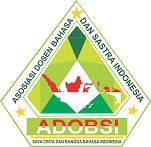Psikoanalisis Tokoh Remaja dalam Novel Misteri Cinta Segi Lima karya S.Mara GD
DOI:
https://doi.org/10.21776/ub.hastawiyata.2019.002.02.05Keywords:
psychoanalysis, adolescence, novel Misteri Cinta Segi LimaAbstract
Teenagers figure in MCSL novels have psychological problems due to family chaos and divorce, they behave deviantly. This paper discusses the psychology of adolescent figures in the MCSL by applying Freud's psychoanalytic theories. Psychoanalytic theory is used to find out how deviations occur in characters and what causes them. The difference seen is in the way they react to the id and anxiety’s pressure. Not all teens react negatively or aggressively to the problems they face. Parenting style and closeness between family members determines the output of behavior that is raised by adolescents as a reaction to the problems they face. Adolescents with good parenting and closeness, to the parents, can refrain them from aggressiveness actions. S. Mara GD., as a novel writer, proved to be very capable of developing the personality of adolescents figures in his novel in real terms. The aesthetic and mimetic intelligence in the MCSL novel is shown by presenting teen figures who are psychologically real.
References
Al-Mighwar, M. (2006). Psikologi Remaja. Bandung: Pustaka Setia.
Alwisol. (2007). Psikologi Kepribadian. Malang: UMM Press.
Barry, P. (2002). Beginning Theory – An Introduction to Literary and Cultural Theory (2nd ed.). Manchester: Manchester University Press. Diambil dari http://www.sgtbkhalsadu.ac.in/colleges/tutorial/112710122014013356.pdf
Dewan Redaksi Ensklopedi Sastra Indonesia. (2013). Ensiklopedi sastra Indonesia / disusun oleh Dewan Redaksi Ensklopedi sastra Indonesia. Bandung: Titian Ilmu.
Eagelton, T. (1996). Literary Theory : An Introduction (2nd ed.). Massachusetts: Blackwell Publishers.
Hall, C. S. (1959). Sigmund Freud – Pengantar ke dalam Ilmu Jiwa. Bandung: FKIP Univ. Padjajaran.
Hall, C. S., & Lindzey, G. (2000). Teori-teori Psikodinamik (Klinis). (Supratiknya, Ed.). Yogyakarta: Kanisius.
Mara GD, S. (2005). Misteri Cinta Segilima. Jakarta: Gramedia Utama.
Minderop, A. (2011). Psikologi Sastra – Karya Sastra, Metode, Teori, dan Contoh Kasus. Jakarta: Yayasan Pustaka Obor Indonesia. Diambil dari http://staff.uny.ac.id/sites/default/files/pendidikan/else-liliani-ssmhum/literary-theory-terry-eagleton.pdf
Ratna, N. K. (2012). Teori, Metode, dan Teknik Penelitian Sastra. Yogyakarta: Pustaka Pelajar.
Ryan, M. (2011). Teori Sastra – Sebuah Pengantar Praktis. (B. A. Ismayasari, Ed.). Yogyakarta: Jalasutra.
Santrock, J. W. (2002). Life-Span Development – perkembangan masa hidup (1st & 2nd ed.). Jakarta: Erlangga.
Soedjijono. (1984). Pengetahuan dan Apresiasi Sastra. Malang: JPBI-FPBS IKIP.
Wellek, R., & Warren, A. (1949). Theory of Literature. New York: Harcourt, Brace and Company. Diambil dari https://archive.org/stream/theoryofliteratu00inwell/theoryofliteratu00inwell_djvu.txt














